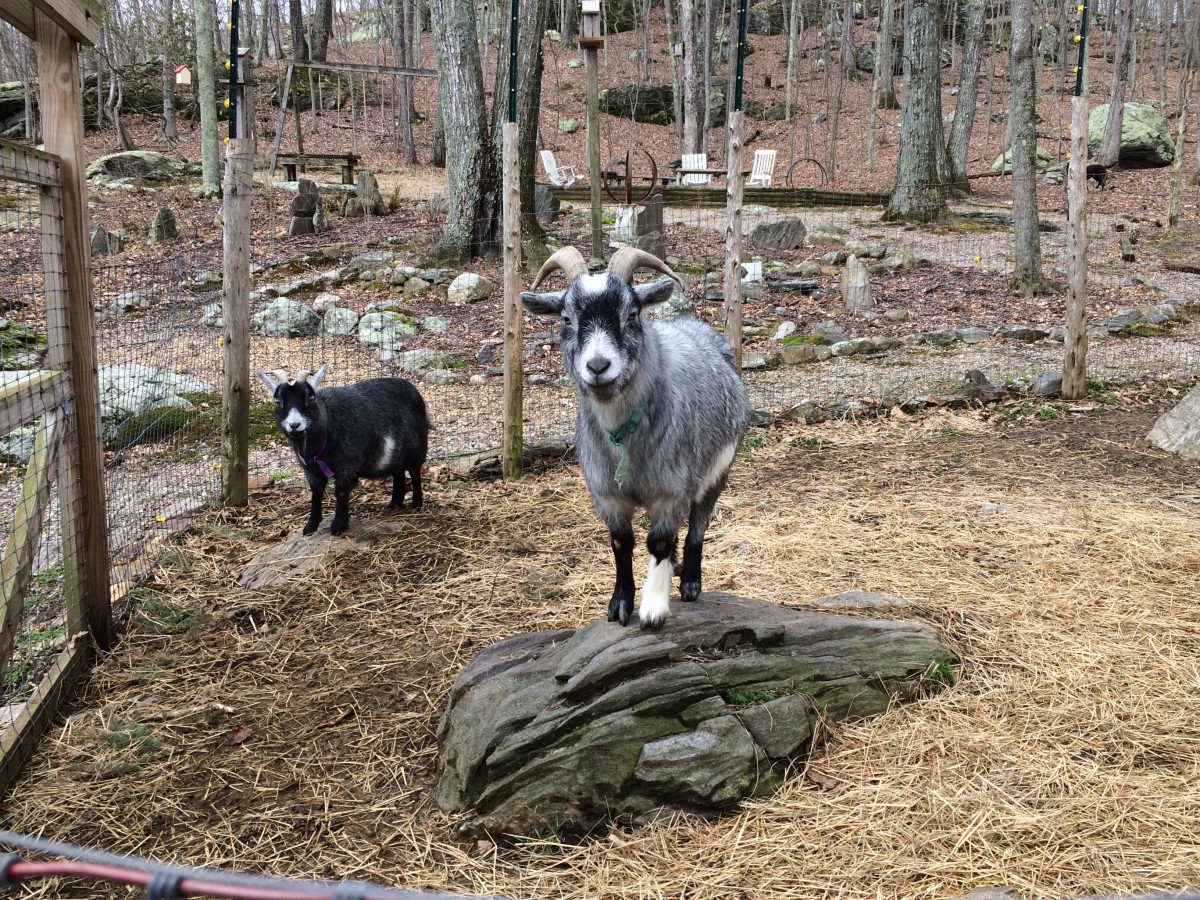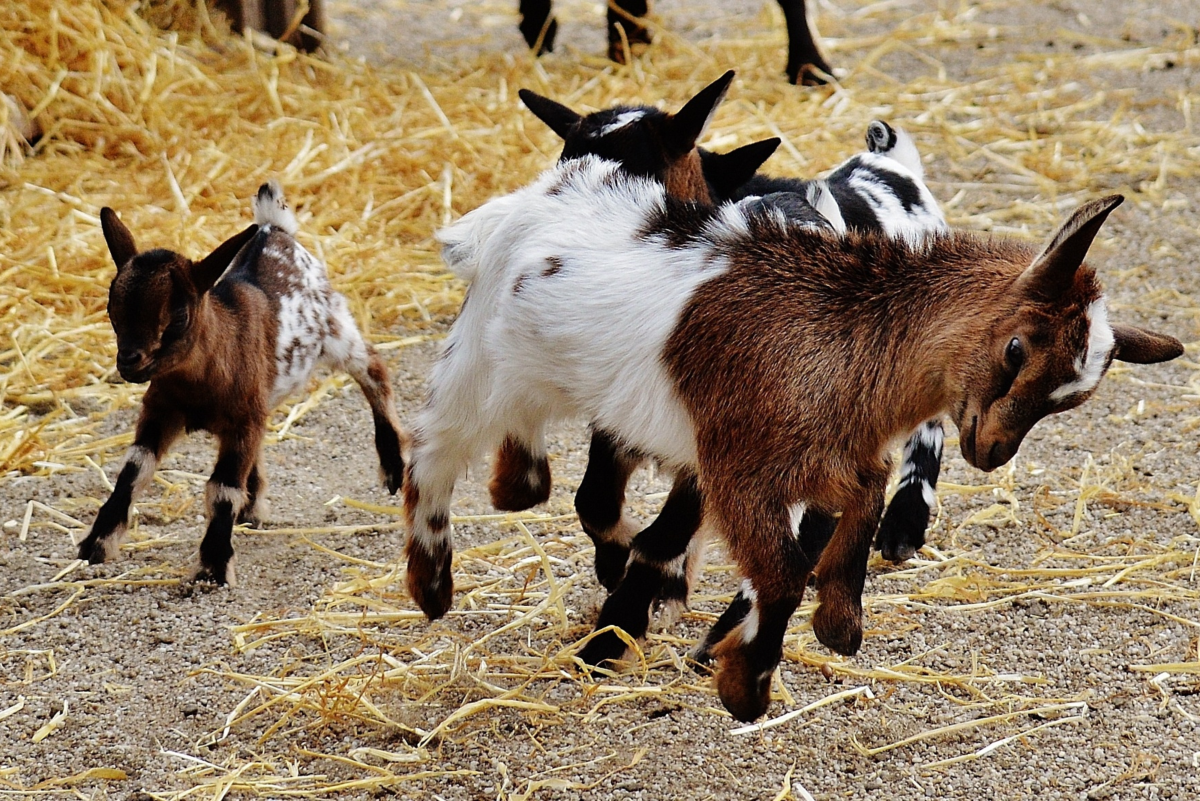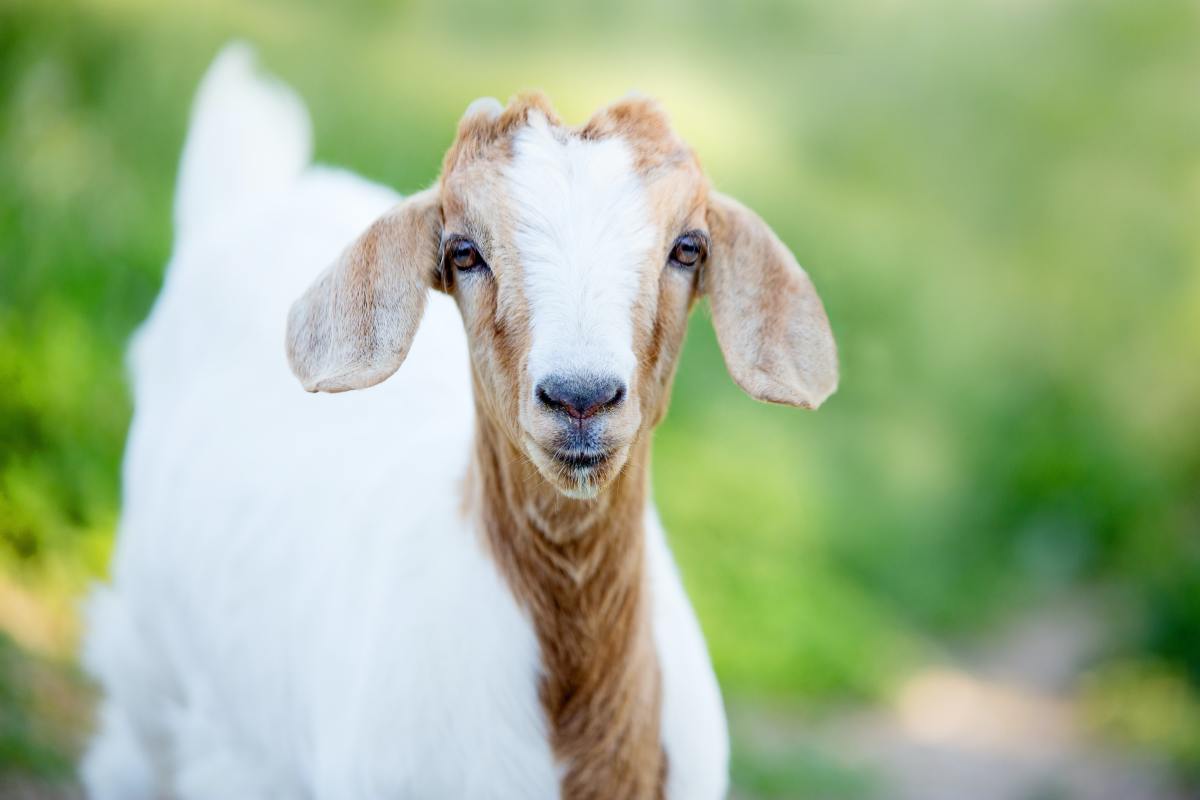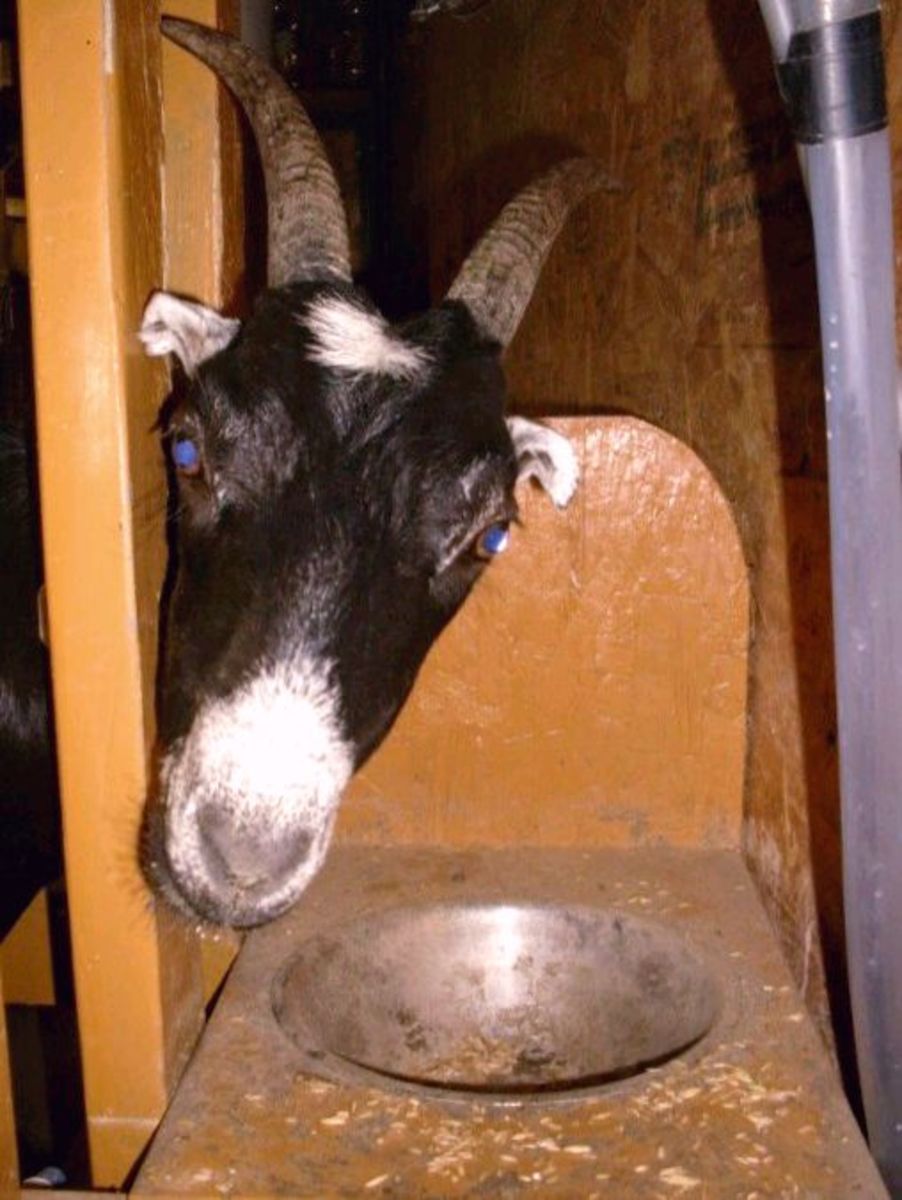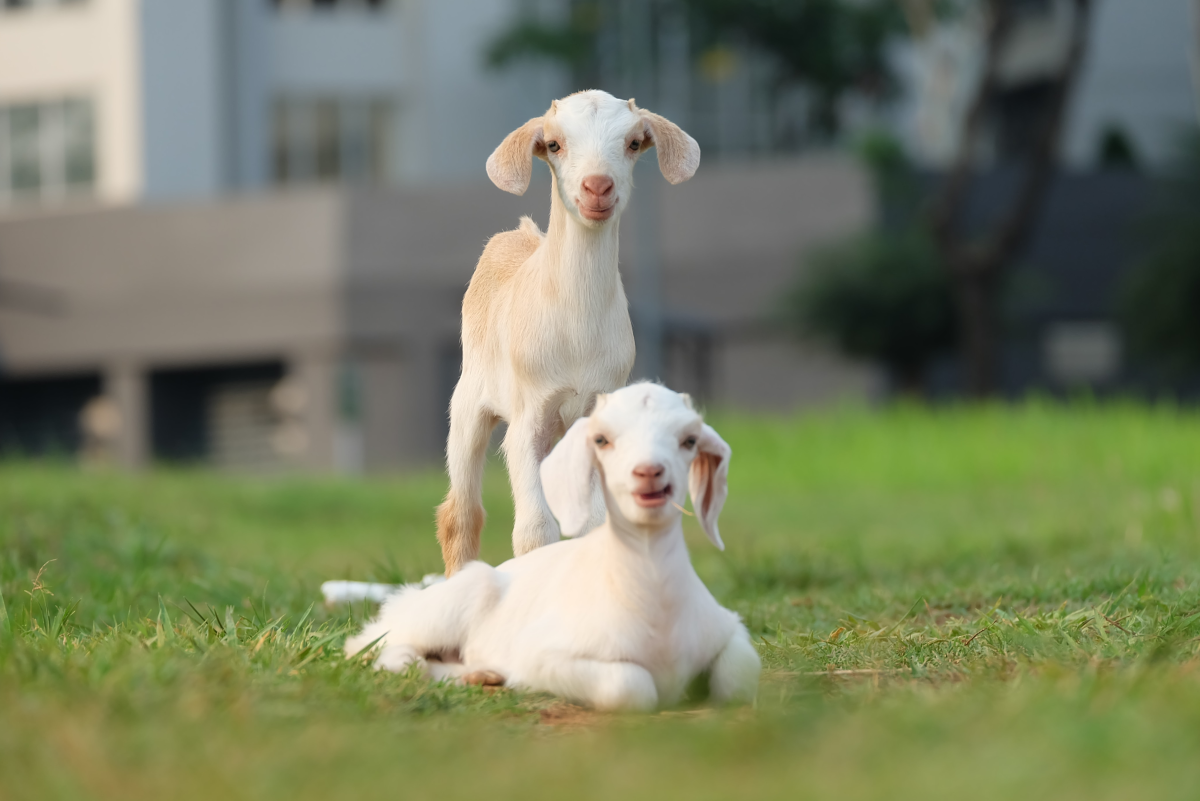How to Manage a Goat Ranch
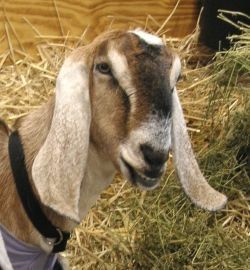
Slightly More Advanced Tips
For folks who already know that in order to run a goat ranch, you have to buy or acquire some goats, build fences for them, and feed them. :) These are some personal tips I learned over the years, which I will pass on. Some of these are apparently not common knowledge.
I raised goats for the milk, and also to some extent for the meat. My favorite part was the liver. Goat meat isn't bad, but I never really developed a taste for it. The milk can be absolutely wonderful!
I kept four breeds of goats. I had Toggenburgs, Saanans (and Sable Saanans, which later became a separate breed, I understand), Nubians, and I had one La Mancha, who didn't live long enough for me to learn much about the breed. Unfortunately, our dog got into the pen where she was, and killed her in self defense. :( Keep your pens in repair! We used chain link fence, which works well as long as goats can't get under it.
Toggenburgs are primarily brown, with white face stripes. They have erect ears, as do Saanans. La Manchas have a very tiny ear. Saanans are normally white, while Sable Saanans are predominantly black (a recessive color, I think) with white face stripes. Nubians come in many different colors and may have blotches of color.
At first, we only had two goats, and then three. We built a lean-to from two sheets of laminated wood, like an A frame. Providing shelter for goats is a good idea if the climate is harsh. Providing shade in warm climates is also a good idea. Ultimately, we built a small barn, with an area specifically for goats. It was about 20 feet long and 6 feet wide, if I recall correctly, and had a roof. The goats would use it when the weather was bad or hot.
The photo is a Nubian, and was published by TTaylor under the Gnu free documentation license, Creative Commons attribute share alike 3.0. The Nubian was my favorite breed because they have wonderful colors, and because their milk has a little more butterfat, so it is delicious.
Unfortunately, my own personal photos of our goats are buried someplace, but I'll try to add a few when I have time to look for them.
Feeding and Milking Goats
Customarily, goats are fed alfalfa hay, especially in the American southwest. Some fortunate goats might live where they can get fresh alfalfa in the field. We didn't have such a wonderful opportunity for them. Watch carefully. Genetically Engineered alfalfa has been approved. Don't have anything to do with it! You would be asking for trouble, including a bunch of sick and dead goats, and health problems for your family. Also avoid genetically engineered grain (corn is a common problem here).
Milking goats also usually get fed grain. There are a few brands of goat feed (grains) on the market, but we learned not to use them. The problem is they are laden with molasses. Molasses turns the feed into junk food, with the same results as you get when you eat junk food. Toggenburgs are prone to diabetes. Feeding them grain with molasses is the LAST thing you want to do. So we bought organic grains from a local co-op. I put the half day's ration into a bucket and soaked it with water for 12 hours before feeding. This causes the grains to begin to sprout, and they are much more nutritious. The milk from Toggenburgs with diabetes turns "goaty" really fast, and it is not a pleasant taste. However, what I learned (and which as far as I know has not become common knowledge) is that if you give them feed without molasses, and also put a tablespoon of fresh liquid chlorophyll on their grain before they eat it, their milk will remain sweet. Sweet goat's milk is one of the nicest foods on the planet.
You won't get a large quantity of milk with this feed, but what you do get will be very healthful. You might figure one goat per person for all your milk needs.
To milk a goat, you have her stand on what is called a milking stand. This is a wooden stand raised above ground just enough so you can sit comfortably on it, when the goat at a height where reaching for her teats is comfortable. On one end is a vertical piece with a keyhole shaped hole in it. At the top is enough room for the goat's head. There is a chain you fasten across once the goat puts her head down to eat, to keep her from leaving. Goats will quickly learn to accept this arrangement.
The actual method of milking is to grasp each teat in one hand. DO NOT PULL ON THE TEATS. Starting at the top, squeeze off the teat below the bag with your thumb and forefinger. Then squeeze below that with your third finger, while still holding the other two fingers in place. Then squeeze with your fourth finger, and lastly with your little finger. The downward motion of the successive squeeze with fingers will cause the milk to squirt into your bucket.
Once you finish milking, run the milk from the bucket through a milk filter (bought at an animal veterinary store or feed store) which has been shaped like a cone, inside a funnel. This will clean dirt out of the milk. Then refrigerate. You should NOT pasteurize it, because this destroys a lot of the nutrients. It will not make you sick if you are reasonably careful. We never washed our goats' teats or anything like that. We simply filtered the milk. In a couple of decades, no one ever got sick.
We would make goat cottage cheese. Place some milk in a container, inside a very fine cheesecloth (most is too coarse and will let the curds slip through), and let it sit for awhile. It will tend to start to turn into cheese. Then filter out the remaining whey with a milk filter, and enjoy. Some of the details of how to start the cheese are things I no longer remember a couple of decades later, but it isn't hard to do. I don't remember heating the milk. I would prefer not to.
Here is a web page about building a milking stand: Building a Goat Milking Stand.
Here is one page about making goat cheese: How to Make Homemade Goat Cheese with Lemon Juice.
Helping a Goat with Kidding
For the most part, goats will kid without any difficulty. A lot of goat people make a big fuss over this, insisting on being present. I never worried about it. We had difficulty only two times, and I had herds up to 45 goats in size for a number of years.
As I said, we had problems only two times. The first time, the goat really needed a Caesarian section. The vet gave me the option of paying for one ($3000) which we didn't have to spend, or putting the goat down to spare her a painful death. With sadness, we chose the latter. It is one of only two times we felt the need to do this with all our animals, and we also had numerous other animals.
The second time, it was my favorite Nubian. I sure didn't want to lose her. So I acted as midwife with the little knowledge I had. Here's how it went. I saw that she was in trouble. I washed my hands really, REALLY well (because I didn't have any gloves) and inserted my hand into her uterus. The task was to locate the front legs and unbend them so they were pointing forward. A goat kid is born feet first, with head resting on the legs, and then the rest of the kid follows. I reached in, straightened the legs so they were sticking forward, and then let her finish the job. She did just fine.
Goat placentas consist of a number of nodes. They will be born after the kid. The mother doe will chew the umbilical cord and eat the placenta. Let her do this. It is very important to her recovery. Then let the kid nurse on demand.
If you face difficulties that are greater than this, and you don't have veterinary training, it is best to call a vet. There are some who will do "house" calls, and will come out in such a situation, fairly quickly.
Some goat people like to show. I was never interested in that. Because they like to show, they would make sure of the breeding with really high quality animals, and keep pedigrees. When a goat is shown, there are a number of characteristics of conformation the judges look at. The only one that ever concerned me was how the udder was attached. It should be well attached, close to the body, with teats pointing slightly forward. I allowed cross-breeding in my goats because it makes stronger, healthier animals. This is because when you inbreed a given breed too much, some important positive genetic characteristics are lost. Cross breeds are simply hardier.
It all depends on why you want to keep goats, but if you are interested primarily in milk and meat, I do recommend the way we did things.
When it is breeding time, we simply allowed the goats we wanted bred into the pen with the buck we wanted to use. In the end, we had just one buck that we would let stay with the ladies during breeding season. Breeding is necessary for the production of milk. If you let the kid get the colostrum (which is vitally important for immunity), and then you start to take the leftover milk after the kid has fed (when the kid is at least a few days old), the goat will produce some milk for you as well.
By the way, should it happen that you have two bucks in the same pen, and one tries to mount the other, please note it is NOT homo-se/xual behavior. It's domination behavior.
Have you ever kept goats?
Have you ever drunk goats' milk? What do you think of goats?
Have you ever kept goats?
Keeping Goats is good for kids
human, that is
If you are interested in homesteading or in homeschooling, raising goats is excellent for your children. After awhile, I turned all the care of the goats over to our children. We raised seven children, and it was up to them to decide who did each chore. I told them what they chores were, and they divided them up. Our youngest ended up doing a lot of milking, because nobody else wanted to do it. He has awesome muscles in his arms, and he is much faster than I ever was. I felt it was really important for them to work out who did the chores, and to work peacefully while making these decisions. At first, the children actually argued over who GOT to do the chores, but as they got older, this changed. It still worked out. I didn't have to follow them around to make sure the chores got done, or intervene. They simply did it, no questions asked.
Among the chores were feeing the other animals, and cooking supper. Each of our children got one day a week to make supper. As a result, they're all good cooks. This helped with getting their first jobs.
We also built our own home, and everyone worked on it. I was the general contractor. :)
I also took the children to a friend's house to clean out the horse stalls for pay. It's not work that is terribly much fun, but they did it, and the friend was a really good employer, because she made them stick to her standards. As a result of these things, our children are excellent citizens in the work world. They are productive and please their bosses. Nobody ever told our children that there was anything wrong with these kinds of responsibilities. The pay from this job gave them some spending money, especially since we couldn't afford to give them allowances.
Health Problems
I am no expert on all the diseases goats might be able to get. But I had experience with two conditions, and I'll tell about them.
The first problem is widespread. It is caprine arthritis. I believe it is caused by a virus. At the time, I didn't know natural ways to treat viruses, but I do now. It was widely known that the only way to deal with it is to prevent it by not adding any goats that have it to your herd. That is easier said than done, because this is a lentivirus (like HIV) and takes time to show up. In the meantime, the virus can spread. We eventually had it in our herd, and we just put up with it because we didn't know what else to do.
The other was a very peculiar problem. One of our bucks started to get thinner and thinner. So I called the vet, and she said that the buck's jaw was paralyzed. Since a goat has to chew the cud to digest its food, this means any goat that cannot chew will eventually starve. She said there was no cure. She gave us cortisone to use to relieve symptoms, but I only used it long enough to order an herbal mixture that is supposed to regenerate nerves (at that time, the medical Establishment didn't think nerves could be regenerated, but now they know better). As soon as that arrived, I used it, and indeed, his nerves DID heal, and I sold him several years later, fat and sassy!
I don't remember what was in the formula, but if you ever have this problem, go to alternate healers. They have the answer.
Purple Star
Thank you very much for the Purple Star, folks! I deeply appreciate it.
These are just my personal tips. I would love to hear yours.

